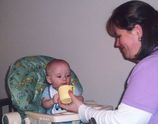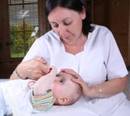Oral Motor Skills and Breastfeeding
Finding the Help You Need
By Caroline L. Bias, M.S., CCC-SLP, Susan Chick, Beverly Morgan, IBCLC
|
The arrival of a new baby is a very emotional time, and unexpected worries about breastfeeding can be overwhelming. Along with concrete breastfeeding questions, the family is now dealing with difficult emotions such as helplessness, fear, anger and grief. Parents often cope by focusing on the goal of getting food into the baby. They may not realize that underlying issues are causing the difficulties. In this article we will look at oral motor treatment options. Many babies have difficulties with oral motor skills and benefit from early intervention. This article provides you with a general idea of what oral motor therapy looks like, the importance of early intervention, and information on who to ask for help.
|
Treatment Plans
Infant oral motor skills play an important role in the success of breastfeeding. In many cases, minor refinement in the infant’s oral motor skills can make an immediate difference to the success of the breastfeeding pair, as well as providing long term benefits and preventing more serious problems.
Babies are individuals, and no one treatment plan works for every baby. It is critical for parents to find qualified professionals who are competent in a variety of therapeutic techniques, and who can identify the right combination for the particular needs of their child and family. Some approaches to oral motor therapy can be more harmful than beneficial, depending on your baby’s specific set of needs.
Developing infants are marvelously receptive and malleable. Being innately designed to learn and to grow makes them particularly responsive to treatment strategies. Treatment may involve supporting the baby’s mouth by placing it into the correct position for feeding; using corrective positioning techniques while baby sucks your finger; positioning the baby more effectively for breastmilk expression; physically exercising the child’s oral and facial musculature, or a combination of these and other techniques.
Infants are eager to imitate from a very young age and imitation is an often recommended strategy. If an infant needs to open wider to get a good latch they will usually do so if you simply say “open” to cue them, and then open your mouth wide as a model for them to imitate. Many babies can respond to the “open” cue right after birth!
Babies are individuals, and no one treatment plan works for every baby. It is critical for parents to find qualified professionals who are competent in a variety of therapeutic techniques, and who can identify the right combination for the particular needs of their child and family. Some approaches to oral motor therapy can be more harmful than beneficial, depending on your baby’s specific set of needs.
Developing infants are marvelously receptive and malleable. Being innately designed to learn and to grow makes them particularly responsive to treatment strategies. Treatment may involve supporting the baby’s mouth by placing it into the correct position for feeding; using corrective positioning techniques while baby sucks your finger; positioning the baby more effectively for breastmilk expression; physically exercising the child’s oral and facial musculature, or a combination of these and other techniques.
Infants are eager to imitate from a very young age and imitation is an often recommended strategy. If an infant needs to open wider to get a good latch they will usually do so if you simply say “open” to cue them, and then open your mouth wide as a model for them to imitate. Many babies can respond to the “open” cue right after birth!
What Therapy Looks Like
Developmentally appropriate “therapy” often looks like play, but it is play with a purpose. Treatment is tailored to the child’s age and skills, and involves games like “peek a boo” and songs combined with oral motor exercises that are designed for your baby. For slightly older children, therapy may include toys such as blowing bubbles or whistles and chewing on specific chewing toys that are provided or recommended by the therapist.
Early sessions focus on getting to know the specific needs of your baby or child, as well as gaining their trust. Much time is spent showing the parents what they can do at home in their everyday routines, including playing games, singing songs and incorporating an “exercise” into activities such as eating or brushing gums and teeth. When the therapist and family incorporate treatment strategies into everyday routines, the child is often very successful.
The most amazing aspect of participating in therapy is just how quickly babies and young children learn new skills and correct their problems. Their nervous systems are so malleable at this age that changes often happen immediately. A qualified professional can show you very small things to do that can make a dramatic difference in a very short time.
There is no special piece of magic that works with every child; there is nothing cookbook about it. Each baby and family have a unique set of needs, and treatment will be tailored by the appropriate professional. As the child responds to treatment, the professional will work with the family to implement new strategies to continue the progress.
For instance, you and your baby might start out by having the therapist or IBCLC show you how to encourage a wider opened mouth. As your baby gets the hang of it and her latch improves, she may still need help with how her lips are sealing. Now the Feeding Therapist may teach you how to exercise your baby’s muscles to get a better seal.
In an older child who is struggling with feeding aversion, your Feeding Therapist may begin by teaching you how to encourage your child to touch more food items. As your child is more receptive to touching the food, the therapist would help your child begin touching food with their mouth, then holding the food in their mouth, and finally, swallowing the food.
All of this talk about therapy can be intimidating. Putting it in context can help. We all need a little help with things from time to time. If your little bundle of love needs help, keep in mind that he is your special gift, to be cherished and enjoyed. He is your wonderful child, not a therapy project. May your wonderful child’s unique personality bring joy to your home.
Early sessions focus on getting to know the specific needs of your baby or child, as well as gaining their trust. Much time is spent showing the parents what they can do at home in their everyday routines, including playing games, singing songs and incorporating an “exercise” into activities such as eating or brushing gums and teeth. When the therapist and family incorporate treatment strategies into everyday routines, the child is often very successful.
The most amazing aspect of participating in therapy is just how quickly babies and young children learn new skills and correct their problems. Their nervous systems are so malleable at this age that changes often happen immediately. A qualified professional can show you very small things to do that can make a dramatic difference in a very short time.
There is no special piece of magic that works with every child; there is nothing cookbook about it. Each baby and family have a unique set of needs, and treatment will be tailored by the appropriate professional. As the child responds to treatment, the professional will work with the family to implement new strategies to continue the progress.
For instance, you and your baby might start out by having the therapist or IBCLC show you how to encourage a wider opened mouth. As your baby gets the hang of it and her latch improves, she may still need help with how her lips are sealing. Now the Feeding Therapist may teach you how to exercise your baby’s muscles to get a better seal.
In an older child who is struggling with feeding aversion, your Feeding Therapist may begin by teaching you how to encourage your child to touch more food items. As your child is more receptive to touching the food, the therapist would help your child begin touching food with their mouth, then holding the food in their mouth, and finally, swallowing the food.
All of this talk about therapy can be intimidating. Putting it in context can help. We all need a little help with things from time to time. If your little bundle of love needs help, keep in mind that he is your special gift, to be cherished and enjoyed. He is your wonderful child, not a therapy project. May your wonderful child’s unique personality bring joy to your home.
Who Treats Motor Oral Issues in Babies?
Internationally Board Certified Lactation Consultant (IBCLC)

An IBCLC is the best place to start in sorting out breastfeeding challenges. An IBCLC can help by initiating strategies for protecting a mother’s milk supply and the breastfeeding relationship. An IBCLC can help with a lowered milk supply, latch issues, pumping, supplemental feeding devices, nipple shields, finger feeding, syringe feeding or Haberman feeders. An IBCLC is also skilled in helping mothers who may be experiencing pain with breastfeeding (whether from chronic nipple pain, mastitis or unknown reasons), getting a baby back to the breast who is refusing to breastfeed, low milk supply, building or maintaining a supply, learning about using herbs and mother foods to support milk supply, or dealing with a baby who is supersensitive to touch or to mother’s milk-ejection/let down.
Feeding Therapists

After problem solving with an IBCLC it is sometimes helpful to consult with a Feeding Therapist. A Feeding Therapist is typically a licensed Speech-Language Pathologist, Occupational Therapist or, occasionally, a Physical Therapist or Nutritionist. When selecting a Feeding Therapist, it is important to find a professional that works with infants as well as one who is comfortable with breastfeeding. Feeding Therapists are experts on the structure and function of the mouth and the swallow and can work in conjunction with you and your IBCLC to help your baby become a more efficient, coordinated feeder.
CranioSacral Therapists

Another therapy that can be helpful for some babies with feeding problems is CranioSacral Therapy. When used in conjunction with speech, occupational or physical therapy it can hasten resolution of issues. CranioSacral Therapy was defined by Dr. John Upledger as a “gentle, hands-on method of evaluating and enhancing the functioning of a physiological body system called the craniosacral system - comprised of the membranes and cerebrospinal fluid that surround and protect the brain and spinal cord.”
Chiropractic Treatment

Many families have seen marked improvements in their child’s feeding skills after chiropractic evaluation and treatment. Chiropractic care remedies the subluxation of the spine that occurs during birth. When selecting any professional it is important to get references from other people who are familiar with them and interview them thoroughly about their experiences with children with feeding problems prior to beginning services.
Myofunctional Therapist
Myofunctional Therapist work to correct swallowing. This depends on a proper relationship between muscles of the face, mouth and throat. The act of swallowing is one function that depends on the body's vital balance. To swallow properly, muscles and nerves in the tongue, cheeks and throat must work together in harmony. When a person swallows normally, the tip of the tongue presses firmly against the roof of the mouth or hard palate, located slightly behind the front teeth. The tongue acts in concert with all the other muscles involved in swallowing. The hard palate, meanwhile, absorbs the force created by the tongue. http://www.myofunctional-therapy.com/what-is-myofunctional-therapy.html retrieved 8/24/14/
Myofunctional Therapist
Myofunctional Therapist work to correct swallowing. This depends on a proper relationship between muscles of the face, mouth and throat. The act of swallowing is one function that depends on the body's vital balance. To swallow properly, muscles and nerves in the tongue, cheeks and throat must work together in harmony. When a person swallows normally, the tip of the tongue presses firmly against the roof of the mouth or hard palate, located slightly behind the front teeth. The tongue acts in concert with all the other muscles involved in swallowing. The hard palate, meanwhile, absorbs the force created by the tongue. http://www.myofunctional-therapy.com/what-is-myofunctional-therapy.html retrieved 8/24/14/
Mental Health Professionals

Mental health professionals are an excellent resource to help families cope during trying times. Mothers may need emotional support when their expectations are not met. They may be grieving over unexpected birth outcomes, separation from their baby after birth, disappointments over breastfeeding expectations compounded by a fussy baby, lack of sleep, lack of support and general worries about their babies. These are often overlooked factors in overcoming breastfeeding obstacles.
How to Locate a Professional ?
- Locate a myofunctional therapist http://www.iaom.com/scope.html
- Internationally Board Certified Lactation Consultant
- Locate a Certified Speech-Language Pathologist in the USA
- Locate a Certified Speech-Language Therapist in Canada
- Locate an Occupational Therapist
- Locate a CranioSacral Therapist
- Locate an Early Intervention Program in the USA NICHCY 1-800-695-0285 (Voice/TT) or ask your local elementary school about who does early intervention in your are.
